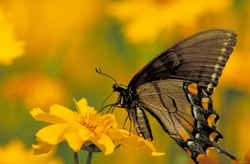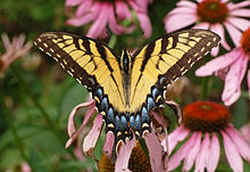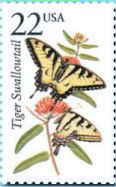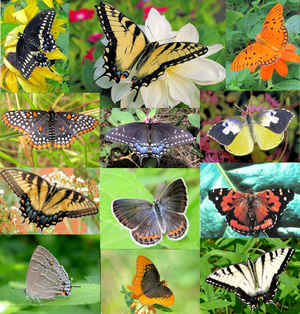Delaware State Butterfly
Tiger Swallowtail Butterfly

(Papilio glaucous)
Adopted on June 10, 1999.
Adopted on June 10, 1999, the Tiger Swallowtail, (Pterourus glaucus,) was declared Delaware State's official butterfly. The tiger swallowtail, a large, yellow, black-striped butterfly, is indigenous to Delaware and can be seen in deciduous woods, along streams, rivers, and wooded swamps, and in towns and cities throughout Delaware. Three butterflies were chosen by students of the Richardson Park Learning Center as possible State butterflies; then 1,611 out of 3,175 public and parochial students all over the State voted to suggest to the Legislature that the tiger swallowtail be named the State's butterfly.
Delaware State Butterfly
Tiger Swallowtail Butterfly

One of our largest, most beautiful, and fairly common butterflies, the Tiger Swallowtail in its light form is unmistakable. But the females in this area can be light or dark. The dark form females are thought to gain protection from predators by mimicking the Pipe Vine Swallowtail. Tiger Swallowtail larvae feed on a number of types of tree including Tulip Tree (Liriodendron tulipifera) and wild cherry (Prunus spp.).
Characteristics of the Tiger Swallowtail Butterfly
The eastern tiger swallowtail, Papilio glaucus, one of the most common and widely distributed swallowtail butterflies in the eastern United States, has a wingspan that can reach 5 inches. The males' bright yellow wings have four black bands on the front wings, and a long black tail on each hind wing, and are easily identified. The first rendering of this species was of an adult male, drawn in 1587 by John White, commander of Sir Walter Raleigh's third expedition to North America. Some females, particularly those in the North, are black, with some blue interlaced with black bands on the hind wings. These females superficially resemble the poisonous blue pipevine swallowtail, Battus philenor.
Life Cycle
- Two flights generally occur in the north, and three or four flights take place as far south as Florida.
- Male swallowtails fly at treetop level and descend to mate with lower-flying females.
- Females lay single, globular greenish-yellow eggs on the surface of leaves, and the young larvae that result are dark and resemble bird droppings.
- The two-inch-long mature larva or caterpillar is bright green and swollen in front, with false black and orange eyespots. These larvae spin a silk "mat" on the leaf, which curls the edges of the leaf somewhat.
- Larvae feed until they are full-grown, then develop into a dark brown or greenish brown caterpillar and descend the trunk of the tree and pupate on the ground, creating a dark stick-like chrysalis in which they overwinter.
- The pupa is light brown with a dark brown or black lateral stripe and dark brown dorsal band.
Habitat

The tiger swallowtail is widely distributed from New England west through the southern Great Lakes area (along Merriam's "transition life zone") through most of the Great Plains states and south to Texas and Florida. In the transition zone, the eastern tiger swallowtail is sympatric with the closely related Canadian tiger swallowtail, Papilio canadensis (until recently, considered a subspecies of P. glaucus).
On June 13, 1987, the US Postal Service issued a sheet of 50 different stamps commemorating American wildlife. Many of the animals in the sheet are native to Georgia, but two - the Tiger Swallowtail butterfly and the Bobwhite - are official state symbols of Georgia. On April 4, 1988, Gov. Joe Frank Harris signed an act of the General Assembly naming the Tiger Swallowtail as Georgia's official state butterfly to mark the opening of the Cecil B. Day Butterfly Center at Callaway Gardens in 1988.
Delaware Law FORMERLY SENATE BILL NO. 85
CHAPTER 44
FORMERLY
SENATE BILL NO. 85
AN ACT TO AMEND TITLE 29 OF THE DELAWARE CODE RELATING TO THE DESIGNATION OF TIGER SWALLOWTAIL AS THE OFFICIAL STATE BUTTERFLY.
BE IT ENACTED BY THE GENERAL ASSEMBLY OF THE STATE OF DELAWARE :
WHEREAS, many states across America have designated an official State butterfly to accompany their State flag, State flower, State bird and State bug;
and
WHEREAS, the State of Delaware, despite its great wealth of indigenous butterflies, has never made such a designation; and
WHEREAS, the students of the Richardson Park Learning Center, aware of this fact, have suggested that the Tiger Swallowtail because of its beautiful
black and orange colors would be especially appropriate as the subject of such designation; and
WHEREAS, the tiger swallowtail, a large, yellow, black-striped butterfly, is one of the most familiar butterflies in North America, is one of the most
common and conspicuous butterflies in the Eastern United States; and
WHEREAS, Tiger Swallowtail is indigenous to Delaware and can be seen in deciduous woods, along streams, rivers, and wooded swamps, and in towns and
cities throughout Delaware; and
WHEREAS, as a result of voting of 3,175 public and parochial students from all over the state of Delaware, of the three butterflies that were chosen
as finalists for adoption by the students of Richardson park learning center the Tiger Swallowtail was chosen by 1,611 students; and
WHEREAS, the butterfly herein designated as the official State butterfly is emblematic and fitting to accompany Delaware's other official symbols,
and
WHEREAS, the designation of Tiger Swallowtail would be highly appropriate not only in its own right, but as a means whereby Delaware State government
might recognize the increasingly vital role played by natural wildlife in Delaware;
NOW THEREFORE;
BE IT ENACTED BY THE GENERAL ASSEMBLY OF THE STATE OF DELAWARE:
Section 1. Amend Chapter 3, Title 29, of the Delaware Code by adding thereto a new section designated as Section 315 to read as follows:
"?315. State butterfly.
The tiger swallowtail (Pterourus glaucus) is the official butterfly of the State."
Approved June 10,1999
Delaware Law
The law designating the tiger swallowtail as the official Delaware state butterfly is found in the of the Delaware Code TITLE 29, State Government, General Provisions CHAPTER 3. STATE SEAL, SONG AND SYMBOLS, Section 315
TITLE 29
State Government
General Provisions
CHAPTER 3. STATE SEAL, SONG AND SYMBOLS
§ 315. State butterfly.
The tiger swallowtail (Pterourus glaucus ) is the official butterfly of the State. (72 Del. Laws, c. 44, ? 1.)
Taxonomic Hierarchy: Eastern Tiger Swallowtail
Kingdom: Animalia (Animals)
Phylum: Arthropoda (Arthropods)
Subphylum: Hexapoda (Hexapods)
Class: Insecta (Insects)
Order: Lepidoptera (Butterflies and Moths)
Superfamily: Papilionoidea (Butterflies and Skippers)
Family: Papilionidae (Swallowtails, Parnassians)
Subfamily: Papilioninae
Tribe: Papilionini (Fluted Swallowtails)
Genus: Papilio
Species; glaucus (Eastern Tiger Swallowtail)
Butterflies, and Bugs








